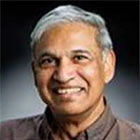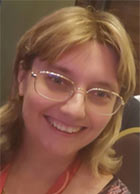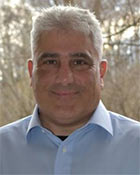Oct
31

Date: 31 October 2024
Time: 11:00 AM ET (New York Time)
Speaker(s): Dr. H. Brian Sequeira, Prof. Corina Nafornita, Mr. Peter Vouras
The webinar is presented by the P3339 Synthetic Aperture Radiometry Working Group of the IEEE Signal Processing Society Synthetic Aperture Standards Committee (SASC).
Abstract
This webinar references theory and practice for the construction of thermographic images from noise emitted by a spatial distribution of sources from a scene that is remote from an array of radiometers. The reference description includes techniques for multiple radiometers that are housed on a single platform such as Earth. Examples of such arrays of radiometers are the Very Large Array (VLA) in Socorro, New Mexico (NM) and the Atacama facility in Chile. A somewhat larger array than the VLA is a facility called New Era that is planned to be located in Nevada (NV). New Era will operate over a frequency range spanning 700 to 2000 MHz. Such a span is large enough that the 2nd harmonic of the lower frequencies lies within the frequency band of operation and presents challenges for the design and operation of the radiometer array. Radiometer arrays have also been carried on a single aircraft (NASA GSFC) and single spacecraft (ESA SMOS) to characterize soil moisture and ocean salinity. Johnson et al have proposed a space-based analog of New Era to operate over a frequency span of 500 to 1400 MHz. Wide bandwidth enables greater spatial resolution of the thermographic image which is essential for characterizing ice depletion in the Polar regions both for the hazard it presents to ships that navigate those waters and for its impact on global climate. Further, the increasingly frequent incidents of fires lend urgency to systems that can image ravaged regions and inform decision makers of the most effective use of fire-containment resources. In addition to bandwidth, better spatial resolution is aided by larger separation between radiometer elements in an array. However, such separations render use of a single platform infeasible. We thus face the prospect of distributing radiometer elements across separate platforms such as a formation of aircraft or a constellation of spacecraft to secure spatial resolutions demanded by future applications. This webinar will discuss the twin challenges of higher bandwidth and larger separation between radiometer elements.
There are constraints that limit the tools that may be brought to bear to respond to these challenges. One of these is rooted in the nature of noise itself. Simply stated, noise lacks temporal coherence. This precludes the use of coherent processing which is the mainstay of synthetic aperture techniques that are utilized in other disciplines such as radar, sonar, and MRI. This constraint arises from the fact that a radiometer is a receive only instrument. It lacks a transmitter and therefore relies for its stimulus, on unknown random thermal fluctuations from an emitter or spatial distribution of emitters. The trend towards higher bandwidth in future systems further narrows the scope of the tools that may be brought to bear. The webinar will present the ripple effects of these constraints, and approaches used to mitigate them.
Biography
 H. Brian Sequeira (SM, IEEE) obtained his PhD in Applied Sciences (electrical engineering) from the University of Delaware , Newark, DE in 1982, USA. He is currently a Principal Professional Staff at the Johns Hopkins University Applied Physics Laboratory, Baltimore, MD, USA. Previously, he was VP of Engineering at GeoPhone Inc. Prior to GeoPhone, he was Principal Scientistic at Martin Marietta (now Lockheed-Martin) Laboratories. His current interests are in deep space communications systems and radar and radiometer instruments for remote sensing from space-based platforms. His previous work was in the design and testing of GaAs ICs at 94 GHz, and as Technical Director of a missile radar program while at Martin Marietta and architecting a ground terminal for communication with geosynchronous satellites while at GeoPhone. Dr. Sequeira is chair of the Synthetic Aperture Radiometry working group, and a member of the IEEE Synthetic Aperture Standards Association. He has published over 50 papers and holds 9 patents.
H. Brian Sequeira (SM, IEEE) obtained his PhD in Applied Sciences (electrical engineering) from the University of Delaware , Newark, DE in 1982, USA. He is currently a Principal Professional Staff at the Johns Hopkins University Applied Physics Laboratory, Baltimore, MD, USA. Previously, he was VP of Engineering at GeoPhone Inc. Prior to GeoPhone, he was Principal Scientistic at Martin Marietta (now Lockheed-Martin) Laboratories. His current interests are in deep space communications systems and radar and radiometer instruments for remote sensing from space-based platforms. His previous work was in the design and testing of GaAs ICs at 94 GHz, and as Technical Director of a missile radar program while at Martin Marietta and architecting a ground terminal for communication with geosynchronous satellites while at GeoPhone. Dr. Sequeira is chair of the Synthetic Aperture Radiometry working group, and a member of the IEEE Synthetic Aperture Standards Association. He has published over 50 papers and holds 9 patents.
 Corina Nafornita (SM, IEEE) received the Ph.D. degree in Electronics and Telecommunications in 2008, from the Technical University of Cluj-Napoca, Romania. In 2003, she joined the Communications Dept. Politehnica University of Timisoara, where she currently holds the position of Professor. In 2015, she successfully defended her Habilitation thesis. Her research interests include signal and image processing, radar, watermarking and wavelets. She is IEEE Senior Member since 2020, an affiliate member of the IEEE Signal Processing Society SPTM Technical Committee since 2015, secretary for IEEE Joint Chapter COM/SP/IT Romania since 2019, and from 2021 she is Chair for the Humanitarian Activities at IEEE Romania Section. Dr. Nafornita is Vice-chair of the Synthetic Aperture Radiometry working group, and a member of the IEEE Signal Processing Society Synthetic Aperture Standards Committee. She has published over 80 papers. Dr. Nafornita is a reviewer for several journals and international conferences. She was Invited Professor at IMS-LAPS, Université Bordeaux I, in 2009 and in 2018, she was Invited speaker at the Workshop in memory of Dr James Nelson, University College London, UCL, Department of Statistical Science. The title of the presentation was "Dr James Nelson: from mathematics to engineering. The Hurst exponent: estimation and applications".
Corina Nafornita (SM, IEEE) received the Ph.D. degree in Electronics and Telecommunications in 2008, from the Technical University of Cluj-Napoca, Romania. In 2003, she joined the Communications Dept. Politehnica University of Timisoara, where she currently holds the position of Professor. In 2015, she successfully defended her Habilitation thesis. Her research interests include signal and image processing, radar, watermarking and wavelets. She is IEEE Senior Member since 2020, an affiliate member of the IEEE Signal Processing Society SPTM Technical Committee since 2015, secretary for IEEE Joint Chapter COM/SP/IT Romania since 2019, and from 2021 she is Chair for the Humanitarian Activities at IEEE Romania Section. Dr. Nafornita is Vice-chair of the Synthetic Aperture Radiometry working group, and a member of the IEEE Signal Processing Society Synthetic Aperture Standards Committee. She has published over 80 papers. Dr. Nafornita is a reviewer for several journals and international conferences. She was Invited Professor at IMS-LAPS, Université Bordeaux I, in 2009 and in 2018, she was Invited speaker at the Workshop in memory of Dr James Nelson, University College London, UCL, Department of Statistical Science. The title of the presentation was "Dr James Nelson: from mathematics to engineering. The Hurst exponent: estimation and applications".
 Peter Vouras (SM, IEEE) currently serves as the Chair of the IEEE Signal Processing Society Synthetic Aperture Standards Committee (SASC) and was the founding Chair of the Synthetic Aperture Technical Working Group (TWG). Mr. Vouras is a twice-elected member of the Sensor Array and Multichannel (SAM) Technical Committee and has co-organized several conference special sessions, journal special issues, and the 2024 NIST-IEEE Conference on Computational Imaging Using Synthetic Apertures (CISA). Mr. Vouras obtained a M.S.E degree in Electrical and Computer Engineering from the Johns Hopkins University, Homewood Campus, Baltimore, MD in 2001, a B.S. degree in Electrical and Computer Engineering from George Mason University, and B.A. degrees in Economics and Foreign Affairs from the University of Virginia. He is currently with the U.S. Department of Defense and was previously with the Wireless Networks Division of the Communications Technology Laboratory at the National Institute of Standards and Technology (NIST) in Gaithersburg, MD (2016 to 2022). From 1996 to 2016, Mr. Vouras was with the Advanced Signal Processing Section of the Radar Division at the Naval Research Laboratory (NRL) in Washington, D.C.
Peter Vouras (SM, IEEE) currently serves as the Chair of the IEEE Signal Processing Society Synthetic Aperture Standards Committee (SASC) and was the founding Chair of the Synthetic Aperture Technical Working Group (TWG). Mr. Vouras is a twice-elected member of the Sensor Array and Multichannel (SAM) Technical Committee and has co-organized several conference special sessions, journal special issues, and the 2024 NIST-IEEE Conference on Computational Imaging Using Synthetic Apertures (CISA). Mr. Vouras obtained a M.S.E degree in Electrical and Computer Engineering from the Johns Hopkins University, Homewood Campus, Baltimore, MD in 2001, a B.S. degree in Electrical and Computer Engineering from George Mason University, and B.A. degrees in Economics and Foreign Affairs from the University of Virginia. He is currently with the U.S. Department of Defense and was previously with the Wireless Networks Division of the Communications Technology Laboratory at the National Institute of Standards and Technology (NIST) in Gaithersburg, MD (2016 to 2022). From 1996 to 2016, Mr. Vouras was with the Advanced Signal Processing Section of the Radar Division at the Naval Research Laboratory (NRL) in Washington, D.C.
